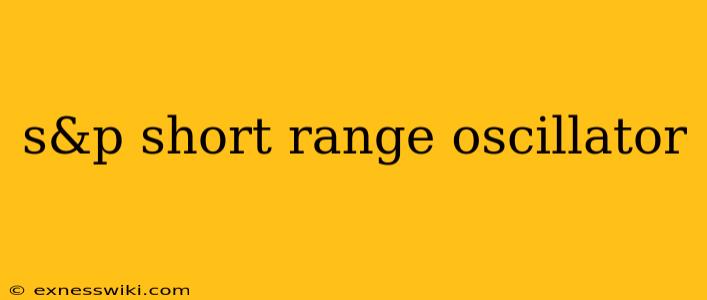Unlocking the Secrets of the S&P Short-Range Oscillator: A Guide to Navigating Market Trends
Remember that time you were trying to predict the market's next move? You were glued to the charts, analyzing every dip and spike, yet the market seemed to be dancing to its own tune. It was like trying to catch a greased pig – a lot of effort, but little success. That's where the S&P Short-Range Oscillator (SRO) comes in.
My personal experience: I first encountered the SRO during a particularly volatile period in the stock market. I was feeling overwhelmed by the constant fluctuations and struggling to make informed decisions. Then, I stumbled upon this indicator and was fascinated by its ability to highlight potential turning points in the market. It felt like a powerful tool to cut through the noise and gain a clearer picture of the market's direction.
What is the S&P Short-Range Oscillator (SRO)?
The SRO is a technical indicator that measures the momentum of the S&P 500 index. It's essentially a short-term oscillator, designed to help traders identify potential overbought and oversold conditions in the market.
Think of it like a temperature gauge for the stock market. When the SRO is high, it suggests the market is getting hot (overbought) and could be due for a pullback. Conversely, a low SRO suggests the market is cooling down (oversold) and might be poised for a rebound.
How Does it Work?
The SRO is calculated by subtracting the 10-day moving average from the 5-day moving average of the S&P 500 index. The resulting value is then plotted on a chart, typically with a range of -2 to +2.
Here's where it gets interesting:
- Above +1: The S&P 500 is considered overbought.
- Below -1: The S&P 500 is considered oversold.
Using the SRO: Practical Applications
The SRO is a powerful tool for traders of all levels, providing insights into short-term market trends.
Here are some common applications:
- Identifying potential trend reversals: Watch for divergence between the SRO and the S&P 500 price. For example, if the SRO is making new highs while the S&P 500 price is stalling, it might signal a potential bearish reversal.
- Confirming existing trends: If the SRO is above +1 and the S&P 500 is trending upwards, it reinforces the bullish trend. Similarly, an SRO below -1 confirms a downtrend.
- Identifying potential entry and exit points: Use the SRO to time your entry and exit points based on overbought or oversold conditions.
Remember: The SRO is just one tool in your trading arsenal. It's best used in conjunction with other indicators and sound risk management practices.
The SRO and Its Importance: A Historical Perspective
The SRO was popularized by Dr. Martin Pring, a renowned technical analyst and author. In his book "Technical Analysis Explained," he argues that the SRO is a valuable tool for understanding market sentiment and navigating short-term market cycles.
The SRO has also been adopted by various financial institutions: Including Charles Schwab and Merrill Lynch. This widespread adoption underscores the SRO's relevance and effectiveness in the financial markets.
Navigating the Market with Confidence
The S&P Short-Range Oscillator offers a unique perspective on short-term market momentum. By combining historical data and technical analysis, it helps traders make informed decisions and navigate the unpredictable waters of the stock market.
But remember, it's just one tool in your toolbox. Combine it with other technical indicators, fundamental analysis, and sound risk management strategies for a well-rounded approach to trading.
And finally, don't forget to practice and gain experience. The more you use the SRO, the better you'll understand its signals and how to incorporate them into your trading strategy.
This journey towards market mastery is just beginning! Keep exploring and learning, and you'll be well on your way to achieving your trading goals.
